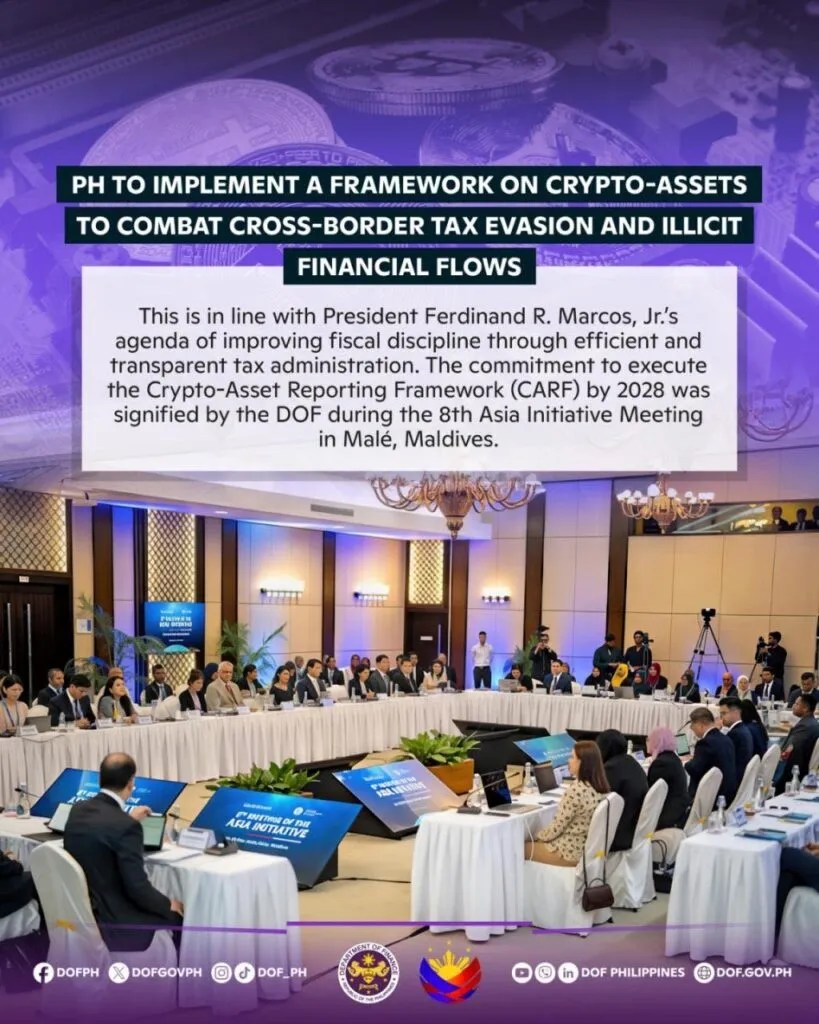The Philippine government has committed to adopt an international reporting framework for digital currency assets by 2028, aligning with global efforts to curb cross-border tax evasion and illicit financial flows. The move underscores the country’s Department of Finance’s (DoF) push to strengthen fiscal transparency as digital currencies become more mainstream in the country.
“We need faster and stronger systems for collaboration if we are to beat tax evasion and illicit transactions,” Ralph Recto, Finance Secretary, said in a statement. “The government must ensure that crypto-asset users are paying their fair share of taxes and that no illicit financial activity goes unpunished.”
Joining 67 jurisdictions in global tax transparency initiative

During the 8th Asia Initiative Meeting held in Malé, Maldives, Finance Undersecretary Charlito Martin Mendoza formalized the country’s commitment to adopt the Crypto-Asset Reporting Framework (CARF), developed by the Organisation for Economic Co-operation and Development (OECD).
The CARF is designed to standardize the automatic exchange of tax information on crypto-assets across jurisdictions. The framework ensures that individuals and entities engaging in cross-border digital asset transactions cannot hide income or gains from tax authorities.
The Philippines joins 67 jurisdictions, 10 of which are in Asia, that have pledged to implement the CARF by either 2027 or 2028. The timing of the country’s commitment aligns with the end of President Ferdinand Marcos Jr.’s six-year term, during which fiscal discipline and transparency have been recurring themes.
“This is a timely commitment as digital currency becomes one of the preferred means for transactions,” Recto noted.
Digital currency growth and risks in the Philippines
Recto previously stated that Filipinos have invested an estimated PHP6 trillion ($107 billion) in digital currencies, more than double the combined size of the country’s business process outsourcing and offshore gaming sectors.
“In the Philippines, a lot of Filipinos have already invested in crypto. Something like 6 trillion pesos worth of investments in crypto is being done,” Recto told Bloomberg in an interview earlier this year. He attributed this growth to a tech-savvy, youthful population and the widespread use of digital wallets, noting that 90 million Filipinos now use such tools to save, invest, and transact.
However, third-party data paints a more measured picture. Blockchain analytics firm Chainalysis estimated the Philippines’ 2024 crypto flows at $43.1 billion, down from $66 billion in 2023. The firm attributed the apparent 40% drop to revised methodologies for tracking decentralized finance (DeFi) activity.
Despite the discrepancy, the numbers underscore the importance of tax authorities keeping pace with the rapid adoption of digital currencies. The decentralized and borderless nature of digital assets presents challenges for enforcement and taxation.
Boosting exchange of information ahead of CARF rollout
The DOF also reported on parallel efforts to improve tax transparency and compliance mechanisms. At the Asia Initiative Meeting, the department shared the country’s progress in adopting the Convention on Mutual Administrative Assistance in Tax Matters (MAAC), a multilateral tool for tax assessment and collection cooperation.
It also outlined the steps taken to prepare for the Enhanced Monitoring Process, the strengthening of the Exchange of Information (EOI) on request, and the adoption of the Common Reporting Standards (CRS).
The Asia Initiative aims to enhance international cooperation on tax transparency and combating illicit financial flows. The Philippines became a member in 2023 and has since been working to align with globally agreed-upon standards.
The meeting also marked the launch of the 2025 Tax Transparency in Asia Report, which details regional progress made in applying tax transparency frameworks throughout 2024.
Globally, efforts in tax transparency have proven effective. From 2009 to 2024, at least €24 billion ($27 billion) in additional revenue has been identified through EOI, offshore investigations, AEOI (Automatic Exchange of Financial Account Information), and related disclosure programs. In 2024 alone, €1.9 billion ($2 billion) in undeclared income was identified through these means.
Raising revenue without tax hikes
The CARF commitment comes as the Marcos administration reiterates its intention not to introduce new taxes. Instead, it aims to increase state revenue through improved collection and enforcement.
This policy direction already has been bearing results, according to the government agency. In April 2024, revenue collection reached PHP522.1 billion ($9 billion), bringing the total for the first four months to PHP1.5 trillion($26 billion). Of this, 94% came from taxes, thanks to an 11.49% increase in tax revenues.
The DOF says the digital currency framework complements these efforts by plugging gaps in areas where tax evasion risks are highest.
Watch: The Philippines is moving toward blockchain-enabled tech
title=”YouTube video player” frameborder=”0″ allow=”accelerometer; autoplay; clipboard-write; encrypted-media; gyroscope; picture-in-picture; web-share” referrerpolicy=”strict-origin-when-cross-origin” allowfullscreen=””>
Source: https://coingeek.com/philippines-to-implement-crypto-tax-framework-by-2028/